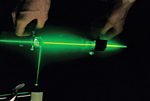
Life Science Optics

Raman spectroscopy directly probes the vibrational and rotational states of a molecule via scattering from a molecule of  merely one photon in a million. Unlike infrared spectroscopy, no sample preparation is required, nor is there interference due to water content in the sample. Samples can be analyzed against a library in the field using non-destructive, point-and-click instruments.
merely one photon in a million. Unlike infrared spectroscopy, no sample preparation is required, nor is there interference due to water content in the sample. Samples can be analyzed against a library in the field using non-destructive, point-and-click instruments.
For this reason, Raman spectroscopy has become a popular technique for identification and analysis in diverse fields like process and pharmaceuticals, explosives detection, semiconductor processing quality control, and biotechnology. It is also used in many fields of research, including carbon nanomaterials.
The high power of the excitation laser and extremely low signal levels generated require optical filters with high efficiency and high laser damage threshold. Longpass detection filters with steep edges offer more Raman spectral information than low-cost filters, while high quality shortpass filters offer the broad passbands needed for useful anti-Stokes spectra to be acquired.
Coherent anti-Stokes Raman Scattering